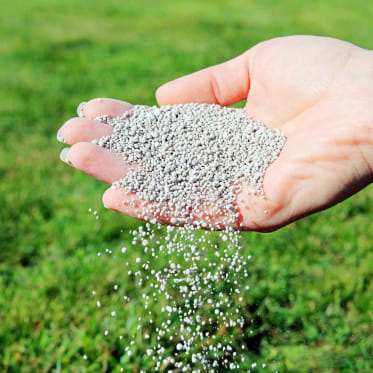Frequent search terms

- COMPO
- Guide
- Plant Care
- Lawns
- Planning and care
- Lawn care in the spring
5 steps to a healthy lawn
Lawn care in the spring
Spring is the perfect time for slow-release fertilisation. Scarifying and reseeding gaps are also recommended at this time of year. But when is the right time for this and what order should you do it in? This article gives you a five-step lawn care plan that will help you to get your lawn back into shape quickly in the spring.
Table of content
1st step
Preparing the lawn in the spring

Clear view for taking stock
Clean up and level out the lawn
How does your lawn look after the winter months? Has a lot of moss spread, have molehills popped up everywhere or are there large patches with nothing growing at all? To answer such questions, you first need a clear view of the lawn. That's why cleaning up the lawn comes at the top of the list of lawn care tasks in the spring. Remove any brushwood, leaf debris and dead plant parts, preferably with a sturdy metal rake. This will also remove dead blades of grass from the lawn and reveal how much of it is still intact. Molehills can also be levelled quite easily with a rake. Spread the soil from them very thinly across the lawn so that it's easy for the blades of grass to grow through it.

Heavily compacted soils
Aerating and sanding the lawn in the spring
If the structure of the soil is so compacted in places due to heavy use, snow and rainfall that puddles form on the surface, then penetrate the soil deeply in those places several times with a digging fork. Special gardening tools called aerators are also available for this. These penetrate the soil countless times, making 5-10 cm holes in the process and thus supplying it with oxygen. Many scarifiers are also capable of aeration and enable you to complete both tasks together at a later date.
If the garden soil is generally clayey and heavily compacted, it's worth sanding the area repeatedly during the spring over several years. Mind you, this alone will not help to prevent puddle formation and waterlogging, as the rain only washes the sand about 10-15 cm deep into the soil, but at least the blades of grass will have an airy bed to grow in. You've probably already guessed that the combination of aerating and sanding is the most efficient way to deal with a compacted lawn, as the many fine holes allow the sand to penetrate much deeper into the soil and it doesn't take several years for the sand to work. This will enable you to improve the structure of the soil over the long term in the course of your annual lawn care.
2nd step
Fertilising lawns in the spring

First strengthen, then remove and sow
Fertilise at the end of March and deal with any moss
First strengthen, then remove and sow – the guiding principle of our graduate horticulturalists. Since lawns will only grow when the soil temperature is at least 10 °C, it's usually far too early for reseeding at the end of March. You should definitely not start your spring lawn care activities with scarifying, either, as the soil is completely sodden and you could do more harm than good due to the lawn's weakened roots.
To preserve as much of the lawn as possible, your first job after the winter should be to strengthen it with nutrients. When selecting a suitable starter fertiliser, it's important to ensure that the fertiliser first promotes healthy root growth and then the formation of a thick, lush green sward. A lawn fertiliser's ability to act at low temperatures is also strongly dependent on the quality of the nutrient combination it contains. COMPO's slow-release lawn fertilisers such as the COMPO Slow Release lawn fertiliser have precisely these special properties, making them perfect for fertilising in the early spring.
But one other thing you can also consider if your lawn is heavily infested with moss is COMPO Lawn Fertiliser Moss? No thanks. In the event of weeds and moss infestation, scarifying is one of the next things on the agenda. A scarifier will be able to completely remove all the dead moss from the lawn with ease.

Alternative moss control
Should you spread lime over the lawn in the spring?
A pH of between 5.5 and 6.5 is ideal for a healthy lawn. If the pH is less than that, the lawn cannot absorb many nutrients from the soil and fertilising won't have the desired effect. On the other hand, moss thrives in acidic soil with a low pH and finds it twice as easy because the weakened lawn grasses make room for it readily. Liming raises the pH of soil and makes life difficult for moss in the process.
But there are three things you need to consider before you decide to lime your lawn.
- Measure the pH before you apply the lime, as it will only be an effective means of combating moss if the pH was actually too low to begin with. Simply liming without first measuring the soil's pH is definitely not a good idea. This can upset the balance of the garden soil unnecessarily.
- Lime is not a fast-acting product and it will take several months for the desired effect of the pH adjustment to occur. In addition, a lot of water is needed for the lime to dissolve completely. For that reason, we recommend that you lime the lawn in the autumn. This will give it until the spring to act and nature will take care of the watering all by itself. Of course, it's still possible to apply the lime in the spring.
- If you do apply lime in the spring, then scarify the lawn beforehand. Otherwise, the lime grains will remain on top of the thick layer of moss for a long time and it will take a lot of water for them to reach the soil and start working.
3rd step
Mowing the lawn in the spring

Ideally once a week
Mow the lawn when it reaches a height of 7 cm.
The lawn will start to grow at a soil temperature of 10 °C. 5-6 cm is a healthy cutting height when you mow your lawn in the spring. If you mow the lawn too short, then the individual blades of grass will not be sufficiently protected against the last night frosts. As soon as the lawn has reached a height of 7 cm, it is time for the first lawn cut. You should mow the lawn regularly as needed from that point on, as this will stimulate growth and promote the formation of strong, densely intertwined lawn grasses. While your lawn loves being mowed, weeds and moss suffer from the regular disturbance, so anyone who mows consistently in the spring from the outset gives the lawn a huge advantage over competing plants. But the lawn should be dry when you mow it. Since it can be difficult to find the right time in the spring, weekly mowing may not always be possible. Incidentally, since the lawnmower's blades may be rusty after a winter in the cold tool shed, it can be useful to sharpen them before mowing the lawn for the first time in the spring. This will enable a straight cut and the blades of grass will not fray unnecessarily.
Tip
Always allow at least two days between mowing and the next fertilisation. Otherwise, the salt concentration in the fertiliser can damage the grasses because they still have open cuts during this period.
4th step
Scarify the lawn in the spring

Lengthwise and crosswise
Scarify 3-4 weeks after fertilisation
If your lawn is heavily matted or infested with moss, it should be scarified 3-4 weeks after the first fertilisation if the lawn grasses have already started to grow by then. As important as scarifying is, it is always a major disturbance for the lawn grasses. Ideally, scarifying should only be carried out when the lawn has already been mown once or twice after fertilisation, as the grasses are then strong enough to withstand unnecessary damage. Accordingly, depending on the weather, it may take several weeks longer before you can start this fourth step of the lawn care plan in the spring. For a clean result, scarify both lengthwise and crosswise.
5th step
Reseeding your lawn in the spring

Larger bare patches
Reseed the lawn immediately after scarifying
Larger bare patches should be reseeded immediately after scarifying. Only then does scarifying make any sense at all because otherwise weeds and moss will spread again very quickly in the gaps in the lawn that are created in the process. When reseeding in the spring, it's worth using a specially treated seed mixture that germinates reliably even in unfavourable weather conditions and low temperatures. Otherwise, the seed will rot quickly if there is too much rain and simply won't sprout if it cools down again. Spring is also a good time to repair uneven spots in the lawn. The holes created by voles can then be filled in and simultaneously reseeded in the same step. You must additionally water the lawn after reseeding in the spring even if it still isn't that hot and rains regularly. The seed must never be allowed to dry out during the germination period, which takes about four weeks. It must be kept permanently moist. You should use an automatic watering system if you're not at home.
Products for lawn care in the spring
This might also interest you










